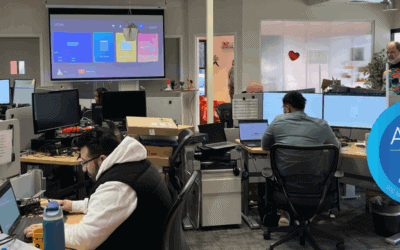Who would have thought a month ago that your entire team would be working remotely and that they would need to be doing it for months? I can’t get the phrase “Crazy Times” out of my head every time I think about it. Do you know who is really enjoying this crazy time? Hackers! Cybercriminals are walking in tall cotton with all the business disruption and opportunity to hack a plethora of new vulnerabilities. As I like to say, “Hackers hack and fiascoes ensue.”
Fortunately, there is something you can do about it to avoid the mayhem.
It is Never Too Late to Worry About your Cybersecurity
Come on and admit it. You don’t worry a whole lot about cybersecurity for your company. You do the basics. You have a firewall. You have anti-virus. Your employees have passwords. You think that no hacker really wants your data. That is never a good perspective to have; it is even worse these days. Life has handed us a golden opportunity. We have a chance to start thinking differently, do some new things, and avoid a major fiasco—or three.
- Be more diligent about phishing emails. Phishing has increased exponentially. Most of them are a spoof of Office 365 in some way. People should be extra cautious.
- It’s time to do more phishing awareness. This would be a good time to start if you are not already doing so. If you are doing it, now is the time to do more of it. Phishing is happening at a greater pace whether you like it or not. At least you have control of your training initiative to help prevent a fiasco.
- Protect Conference calling. I read an interesting Fed article that referenced a NIST infographic for conference calling and security. The article was about more people needing to do conference calls because of working from home. Before this new reality, I had not thought much about conference calling and cybersecurity.
- Be aware of new Videoconferencing vulnerabilities. You went from almost never doing a video call to doing them daily from home with your pets and kids being a part of the action! Talk about excitement. Doing a video call opens up an all-new list of things to worry about for cybersecurity. The main one is to put a password on your conference. Do you really want some rando dropping into your video call? Also do not post the video call info on any public forum! On a side note, remember you are on video and people can see you.
- Update your VPN. This is one of those things that you may have used a long time ago, but may have thought, “Who needs VPN any more with everything in the cloud?” That may be the case for a lot of people, but for many, they have systems in their office that they need to access to do their job. While in the office, it is nothing to think or worry about. Working remotely full time is a whole new paradigm. Is your VPN up to date and can it handle the higher number of users needing it (you may have gone from 2 users leveraging the VPN to a 100)? Are you using the latest VPN best practice setup? Tech changes rapidly so if you have not thought about your VPN in the past few years I’m sure there is a needed upgrade or reconfiguration.
- It is time to set up MFA (Multi-factor Authentication). Even if you have been reluctant to implement this in the past, you should bite the bullet and do it now. Change is already upon everyone and the last thing you want to do is disrupt your employees further, but this is not a sudden reactionary disruption like many of the ones currently happening. This is strategic cybersecurity need that you are looking to start using. People get it and you will be a better company for doing so.
Life is a series of natural and spontaneous changes. Don’t resist them; that only creates sorrow. Let reality be reality. Let things flow naturally forward in whatever way they like. ―
Here Are The Top 10 NIST Cybersecurity Recommendations for Remote Workers
- All the components of telework and remote access solutions, including client devices, remote access servers, and internal resources accessed through remote access, should be secured against expected threats.
- Plan telework-related security policies and controls based on the assumption that external environments contain hostile threats.
- Assume that external facilities, networks, and devices contain hostile threats that will attempt to gain access to the organization’s data and resources.
- Assume that malicious parties will gain control of telework client devices and attempt to recover sensitive data from them or leverage the devices to gain access to the enterprise network.
- A telework security policy should define which forms of remote access the organization permits, which types of telework devices are permitted to use each form of remote access, and the type of access each type of teleworker is granted.
- An organization should make its own risk-based decisions about what levels of remote access should be permitted from which types of telework client devices.
- Ensure that remote access servers are secured effectively and configured to enforce telework security policies.
- Ensure that remote access servers are kept fully patched and that they can only be managed from trusted hosts by authorized administrators.
- If possible, a server should be placed at an organization’s network perimeter so that it acts as a single point of entry to the network and enforces the telework security policy.
- Telework client devices should include all of the local security controls, such as applying an operating system and application updates promptly, disabling unneeded services, and using anti-malware software and a personal firewall.
If you want some more recommendations, please contact me. I’ll be glad to give you the names of some of the tools our clients leverage. Shoot me an email (jahlberg[at]waident.com) or give me a call (630-547-7011)
(NOTE: We do NOT share our tool names via our posts. Cybersecurity best practices recommend NOT to because doing so creates unneeded risks as hackers are always searching for vulnerabilities).
Dig Deeper
Making Smarter Pandemic IT and Cybersecurity Decisions: Avoid Doing Good, Then Getting Hacked
Ransomware Best Practice Checklist
How Do I Know if My Business Computers Have Been Hacked
Documentation – Your IT “Canary in a Coal Mine”






